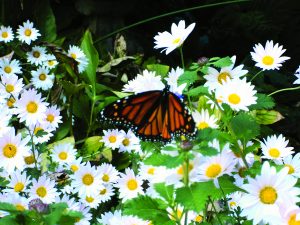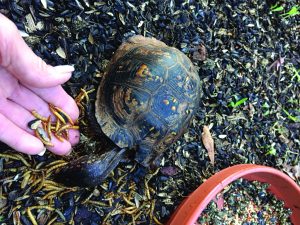Autumn is one of my favorite times of the year. That’s partly because something in the fall air always brings me back to my school days…a fresh start to learn something new. But as a gardener, autumn is more of an ending than a beginning…picking the last vegetables of the season, summer plants dying back, birds flying south, monarchs and cloudless sulphurs migrating, and box turtles on the move. But that doesn’t mean that autumn has to be a sleepy time in the garden. With colorful trees and fall blooming plants like Sheffield Pink Chrysanthemums and Climbing Carolina Asters, these months can be just as colorful and interesting as spring and summer.
Since my garden, WillowDale, is a wildlife habitat it is important for me to have those fall blooming flowers for nectaring butterflies and bees along with host plants for caterpillars. My bird feeders are full of seeds, hummingbirds will have sugar water long into November for late migrating birds and frogs and turtles will have plenty of water until autumn is gone.
This amazing autumn display of wildlife continues to add color and interest to our gardens but my favorite is the Eastern Box Turtle, ‘Terrapene Carolina’. When days get shorter and the air is cooler, these reptilia are on the move getting ready for hibernation; and, you will see them quite often in your gardens.
My garden is surrounded by woodlands making it attractive to many box turtles but ‘Teddy’, well, he is my most heralded star. He is about 6 to 7 years old and has a chip on the front of his carapace, upper shell and loves to eat dry meal worms. He measures about 6 inches long and could grow up to 8 inches…males being larger than females. It was easy to identify him as a male with his thicker tail, brown-red eyes and concave plastron, bottom shell. Females have short tails, yellow-brown eyes and convex plastrons.
With winter hibernation right around the corner, like the flowers, Teddy will soon be gone, too. When plants and bugs are less plentiful, box turtles will survive in a dormant state called brumation similar to mammal hibernation. They will start to eat and move less trying to conserve energy. And 14 days before completed hibernation, they will stop eating and burrow in soft soil or piles of leaves to just below the freeze line. Their metabolism and heart beat will become very slow so that they can safely sleep until spring of next year.
So for now Teddy adds interest and fun to my autumn garden. The fall flowers continue to bloom and add color, birds are still singing and it feels like fall. And even though the autumn ending is near and winter is close by, in a few months spring will bring a new beginning to our gardens full of wildlife, color and interest once more.♦




